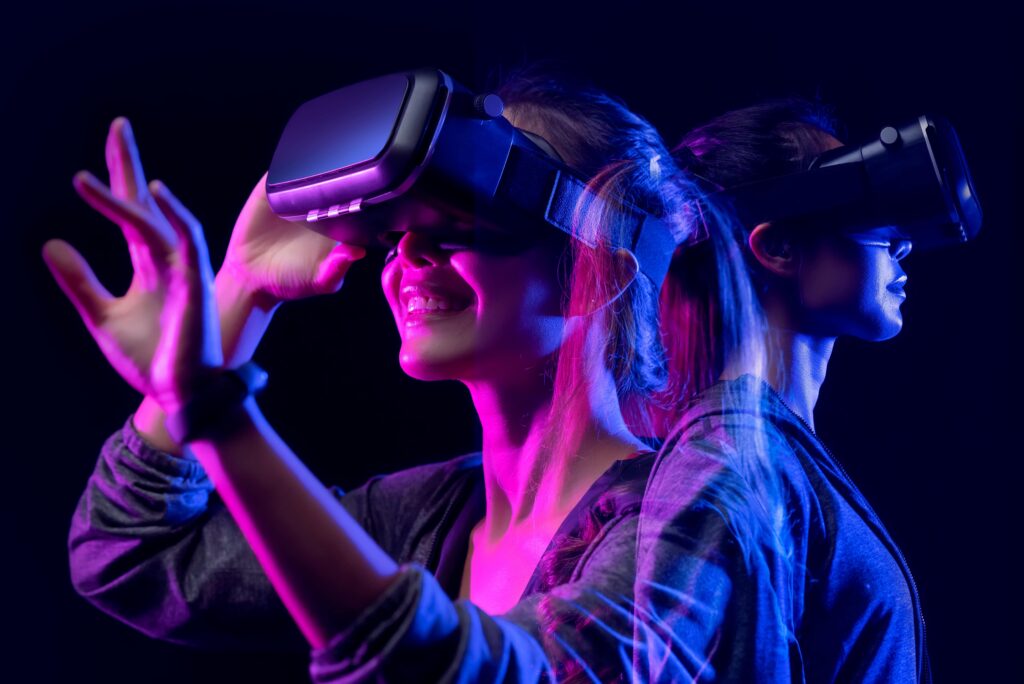
Hamza Khan, co-leader of McKinsey & Company’s Marketing and Sales Practice in the UK and Ireland, speaks to Digital Bulletin about how brands can begin to shape an effective metaverse strategy.
Any science-fiction fan is familiar with the concept of the “metaverse”. Initially coined by Neal Stephenson in his 1992 novel Snow Crash, the term refers to a fully realised digital world that multiple people can inhabit at the same time. Think Ready Player One, Tron, or The Matrix. Now, 30 years after its conception, the metaverse might be ready to leave fiction forever.
Initially driven by video game platforms’ use of virtual and augmented reality technologies (AR/VR), Silicon Valley sees the transition to a real-time and completely interconnected digital experience as the next logical step in the evolution of the internet. Technology leaders such as Mark Zuckerberg envision a world where users move freely between online platforms, with their data automatically transferring from one to the other – a world where people pay with blockchain and buy non-fungible tokens.
But who will realise this virtual vision?
Recognised by Vault as the most prestigious consulting firm in the world, McKinsey & Company serves 90 of the 100 largest corporations globally, playing a key role in their decision-making processes. The firm has led the adoption of every significant business trend in the past century, including the rise of advertising, globalisation, automation, corporate restructuring and, now, the metaverse. Hamza Khan, co-leader of McKinsey & Company’s Marketing and Sales Practice in the UK and Ireland, speaks to Digital Bulletin about how brands can successfully build their metaverse strategy.
“There has been this big resurgence in the notion of the metaverse, and it’s been faster than many of us have been able to keep up with,” he says.
The social implications of the metaverse and how it is evolving human interaction, both between humans, but also between people and brands, and between people and technology, that's as much of a technological question, as a philosophical one
Although many attribute this rise of interest to Facebook’s transition into Meta, the social media giant was not the first company to entertain the idea of expanding into a virtual interactive world. In 2003 there was Second Life, designed as a gamified experience. However, it soon fell from the general consciousness and lost momentum. Until 2021
In addition to Zuckerberg’s metaverse pledge, there has recently been a convergence of factors that have contributed to driving the shift towards immersive experiences. These include technological advances such as the rise of AR and VR, as well as the increase in computer power and processing speeds. However, it is the social trends such the acceleration in e-commerce, the ubiquity of video games and the decentralisation of finance that have forever transformed consumer behaviour, turning the concept of the metaverse into a feasible future.
“We have been looking at trends that have emerged from or been accelerated by COVID-19 and the metaverse has been in the making for far longer,” Khan says.
“Given the spotlight now, we anticipate an acceleration in that innovation, but it’s a bit too soon to say how much that innovation translates into widespread consumer adoption. We were having similar conversations a couple of decades ago about the penetration and prevalence of the internet and we are now seeing what’s happened. We’re in those stages now with the metaverse, but the trends seem to point towards an acceleration, which is not just COVID-driven, but it stretches further back and will stretch further forward.”
Following the footsteps of the internet, the metaverse offers many opportunities for those brands that are brave enough to delve into it, if they do it right.

From gaming to retail, arts and even healthcare, brands of all sectors are looking to adapt their marketing departments to the changing online landscape. During his journey at McKinsey, Khan has led many global organisations in delivering digital growth and innovation, including accelerating e-commerce, building digital ecosystems and new businesses, and deploying agile commercial models across several sectors and regions. Now, he is helping them design strategies to become metaverse-ready.
“For consumers, there has been this promise of a persistent, immersive experience and general interoperability to create one integrated metaverse,” he says. “That idea has been around for a long time, but what we’re seeing now is the ability to move closer in that direction.
“For brands, this is a fundamentally different way to connect with not just consumers but also – thinking longer-term – new segments of the population and younger generations. It’s a new way of engaging consumers. It’s a new way of understanding upcoming segments, and the trends that are very prevalent within those groups in order to, at some point, be able to get them to become consumers.”
The metaverse might still be years away, but we are already witnessing the development of its building blocks. As one of Gartner’s top five emergent technologies for 2022, global spending on the metaverse’s foundational features – VR and AR – is predicted to rise from $12 billion to $72.8 billion in the next two years. However, new technological developments are also needed to ensure the devices can track hand or eye movements and possess high-quality models that can achieve the retina display and pixel density required for a realistic virtual immersion. These devices also need to become lightweight, portable and affordable for the metaverse to witness wide-scale adoption.
So far, the earliest instances of what could eventually become the metaverse can be seen in the gaming industry, with companies like Epic Games’ Fortnite enabling entire interactive concerts where fans can interact with artists such as Ariana Grande, Travis Scott, and Marshmello. These filmed and animated concerts allow fans to navigate the game area, approach the artist’s avatar and even purchase digital merchandising.
But the metaverse is not only the realm of gaming. Nvidia, for example, has created Nvidia Omniverse, an open platform designed to connect 3D spaces into a shared universe to facilitate virtual collaboration between engineers, designers, and creators. It’s currently being used by organisations such as BMW, to reduce production time and improve product quality by smart manufacturing. Nonetheless, Fortnite and Nvidia’s designs are separate tools, not the single interoperable virtual world envisioned by the prophets of the metaverse.
“The technology has come a long way, both in terms of the infrastructure as well as the software solutions being built on top, but there are a lot of challenges to overcome,” Khan says.
“The metaverse is a two-way interaction between two different users and, from that point of view, the largest number of people that you can simultaneously have in a single room in one specific game is currently between 150 to 200. So the millions of users that see when we talk about specific Fortnight concerts is only for a relatively single-directional experience. We’re not at the point yet where thousands of people can persistently be in the metaverse at all times.”
The important thing for businesses and for executives to do is to closely monitor developments within the metaverse and look at what the risks are, and how to stay one step ahead
Identifying the underlying technological shifts that are happening in the metaverse design is a fundamental piece of the puzzle. At the moment, each organisation is developing separate hardware and software to build their versions of the metaverse. While some developers are prioritising a VR-focused vision, others are looking at Ar or mixed realities instead. However, all of these would need to be interoperable if the metaverse is to have a wide scale adoption.
While this world is coming into its own, brands now have the space to experiment and decide which technologies are best suited for their ambitions and communication strategies, instead of rushing to jump in on the trend. In order for brands to succeed in this new universe, the technical capabilities will need to be accompanied by excellent high-level strategies.
“There are different platforms within the metaverse, and there is no interoperability at the moment,” Khan says. “The ambition is that it will be there, but we’re not in that space yet. That’s why I think brands need to think through which of those platforms they see scaling and shifting and going in line with brand objectives.”
“There are a certain number of strategic questions that need to be answered. I think it would be prudent for executives to very clearly focus on those strategic questions, but also be aware of and mindful of the technology that is currently powering the metaverse and how that’s evolving.”
Alongside the technical challenge that Khan identifies, there is a second subset of concerns, related to how the people will behave in this new virtual environment. Risks related to user safety, data privacy and cybersecurity are expected to be front of mind as developers design the future digital landscape.
User behaviour will also have a knock-on effect on brand reputation. When millions of people have access to a digital brand, how can an organisation ensure that their content is protected, and that preferred version of the brand is the one being communicated?
“The social implications of the metaverse and how it is evolving human interaction both between humans, but also between people and brands, and between people and technology, that’s as much of a technological question, as a philosophical one,” Khan says. “Because then it has implications around, for example: What’s the code of conduct? Who enforces it? How do you enforce it? And so, there are all of those challenges to be addressed as well.”

With around 50 million daily users, Roblox is one of the largest engaged communities online. However, over 67% of its users are under 16 years old, so they might not be the preferred target audience for certain brands. It is therefore important for brands to assess what platforms provide the best fits with their brand identity and their strategy, and where they can find the audiences they want to engage with.
Therefore, brands have work to do in regards to figuring out the types of campaigns and experiences that they’re building in the metaverse, scoping out the right partners to work with and deciding which audiences they want to engage, and in which ways. Independently of whether brands decide to focus around virtual goods and NFTs, gaming, or new immersive experiences, they will need to design adequate campaigns and assess the public’s response to them.
“There’s a lot to be said for experimentation,” Khan says “I link it to identifying and starting to build the capabilities that brands will likely need in the future, essentially, planting the flag but doing so with a clear objective of learning by doing, instead of focusing on immediate sales numbers. And that is what many leading brands have started doing with their initial steps.
“In most cases, we’re seeing that the reactions are positive, but there have also been brand engagements with users where the reaction has not been as positive. And so, just being aware of the steps that brands are taking and how users are reacting, I would say is the first most important step. Because then, it allows executives in organisations where the metaverse would be a relevant topic in the coming years to start to shape the answers to the more strategic questions they need to answer before they jump into experimentation.”
It’s still early days for the metaverse and, although its potential is exciting, we still ignore how much of a mainstream phenomenon it will become in terms of consumer adoption, particularly when you take into account all sectors of the population.
According to Khan, brands should be blinded by the metaverse’s promising possibilities. Instead, they should assess what purpose this new platform could serve their organisation and how it fits into their brand and communications strategy, as well as reflect the organisations’ core objectives. Only then, they will be ready to take on the task of targeting this new space.
“I’m reluctant to come up with a tone of ‘it’s now or never’, because I don’t think that tells the full story,” he says. “I think the important thing for businesses and for executives to do – especially in the marketing and sales space, but also much more broadly – is to closely monitor developments within the metaverse, and look at what the risks are, and how to stay one step ahead of them.”
If there is one genre that has always been one step ahead of human development it is, undoubtedly, science fiction. From Star Trek’s flip phones, to Star Wars’ holograms, and including Isaac Asimov’s autonomous cars, Ray Bradbury’s earbuds and Frank Herbert’s drones, countless technologies have made the transition from fiction to reality. With the support of Big Tech and the knowledge of consulting powers like McKinsey & Company, the rise of the metaverse seems not to be a matter of if it’ll happen, but of when, and who will lead it.


